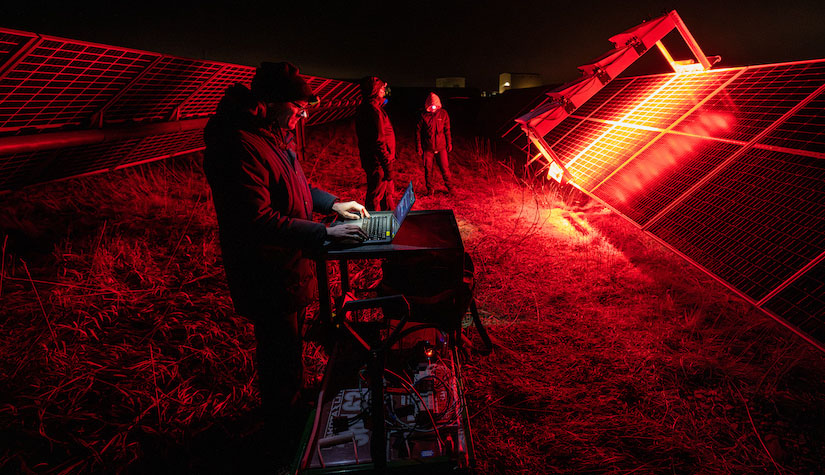DuraMAT Forecasts How New Photovoltaic Module Technologies Might Perform Over 20, 30, or 50 Years
As the Solar Industry Grows Rapidly, Materials, Designs, and Solar Panels Are Changing Quickly

For the solar photovoltaics (PV) industry, rapid growth can produce rapid—and sometimes unpredictable—changes. As the industry continued to see a major period of growth in 2023, the Durable Module Materials (DuraMAT) Consortium seized the opportunity to support the industry's booming domestic manufacturing and deployment sectors by developing guidance for how to build reliable, durable PV modules (also known as solar panels).
The recently released DuraMAT Fiscal Year 2023 Annual Report details the consortium's development of a reliability forecasting strategy, as well as key findings on the impacts of cell cracks, high-efficiency modules, materials degradation, and recycling.
DuraMAT is led by the National Renewable Energy Laboratory (NREL), with Sandia National Laboratories and Lawrence Berkeley National Laboratory as core research labs, and is funded by the U.S. Department of Energy Solar Energy Technologies Office.
Their annual report reveals new strategies and recommendations to benefit today's manufacturers and tomorrow's consumers.
With New Materials Come New Behaviors, Which Past Experience Might Not Predict
Currently, reliability testing in the solar industry relies on factors observed in the field with existing modules, but the industry is innovating so quickly that the performance of today's fielded modules is no longer always a reliable indicator of what will happen in the future. To address this development, DuraMAT introduced a new focus on reliability forecasting in 2023.
"We awarded six projects under our reliability forecasting call this year," said Teresa Barnes, DuraMAT director and NREL researcher. "These projects are forecasting possible degradation factors like ultraviolet (UV)-induced degradation, glass fracture mechanics, and degradation mechanisms in encapsulants, as well as providing faster analysis of failure data. Drawing insights from all these areas should give us the capability to predict the long-term reliability of new module designs."
Instead of starting from field observations of wide-scale problems after deployment—as PV reliability research has done traditionally—DuraMAT's reliability forecasting starts from fundamental research questions about how a material, interface, component, or module will change over many years.
This approach is built on quantitative modeling and rapid validation, which has led to the development of a suite of open-source software and datasets on topics such as mechanical models for materials, wind loading, fracture mechanics, moisture diffusion, and irradiance—all accessible through the DuraMAT Data Hub.
Cell Cracking and UV Degradation—Lessons for Industry
In 2023, DuraMAT projects explored two other degradation mechanisms that appear to be evolving with new module designs: cell cracking and UV degradation.
Cracked cells are a challenge for the solar industry because they can reduce output but often go unnoticed. Researchers found that some newer modules with many busbars, half-cut cells, and glass–glass encapsulation are more tolerant of cracked cells and less likely to show power loss. Module design changes such as rotating cells in the module can also make modules less sensitive to cell breakage.
DuraMAT researchers also found that UV-induced degradation appears to be a significant issue in recent modules made with high-efficiency cells. These results are important, as the increased degradation related to UV exposure in modern cell types may offset some of the gains predicted from bifacial and other high-efficiency cells. DuraMAT is starting new work to quantify this degradation in 2024.
Queuing Up the Next Generation of PV Reliability Leaders
Taking the long view is the whole point of the DuraMAT Consortium. The DuraMAT Early Career Scientists (DECS) program is an extension of that forward-looking approach—after all, solar module lifetimes are only expected to get longer, and the industry will need scientists to support this reliability research well into the future.
The DECS program aims to connect early career scientists, foster collaboration across institutions, and offer professional development and networking opportunities to these important and innovative new researchers. This year, DECS participants continue to represent DuraMAT by giving research presentations, acting as session chairs at national and international conferences, and publishing papers—all of which can be found in the DuraMAT annual report.
Dig Into the Details
"We know that DuraMAT research is having a direct effect on PV module design and durability," said Michael Owen-Bellini, a DuraMAT leadership fellow and researcher at NREL. "For example, one of the projects detailed in the annual report demonstrates that rotating half cells in module designs makes modules more mechanically durable—and we're seeing this reflected in some of the latest half-cell modules on the market."
Access the full DuraMAT FY 2023 Annual Report.
Learn more about DuraMAT's history and research in this 2022 NREL feature story.
Contact duramat@nrel.gov to learn more about working with the DuraMAT Consortium.
This article has been updated to reflect an editorial change made after its original publication.

